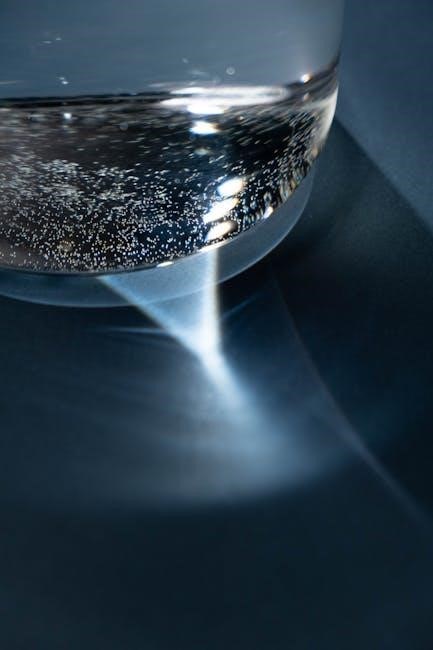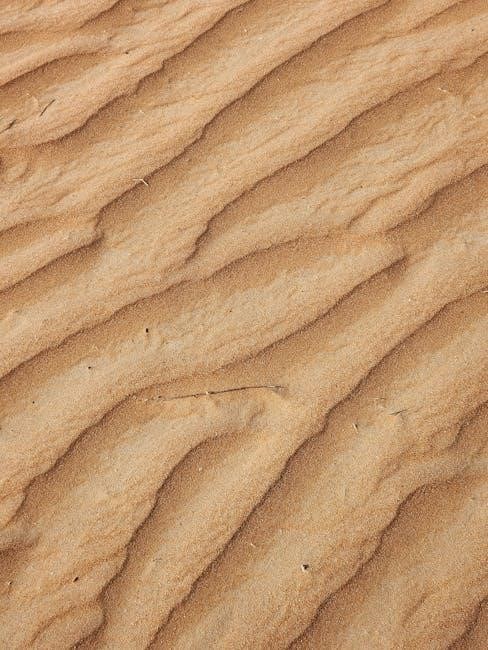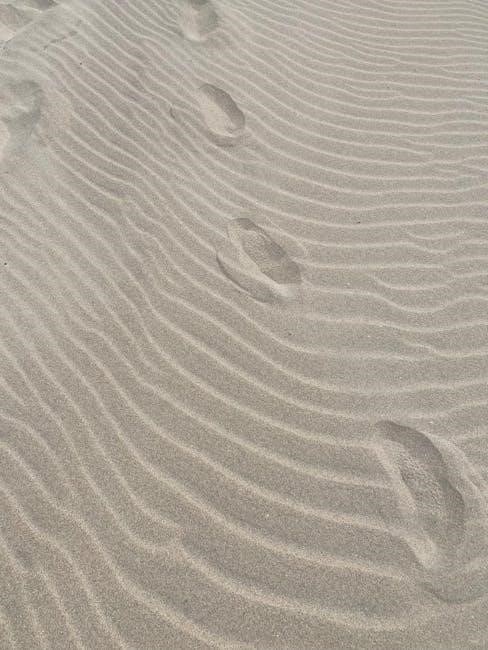
Surface area of prisms is the total area of all faces. It is crucial for painting, packaging, and material usage. Use nets or formulas to calculate it accurately. Always ensure unit consistency for real-world applications. Practice with PDF worksheets to master the concept effectively.
1.1 Understanding Surface Area
Surface area is the total area of all exposed faces of a prism. It is calculated by summing the areas of all individual faces. For prisms, this can be done using nets, which unfold the 3D shape into a 2D layout. Understanding surface area is essential for real-world applications like painting, packaging, and material usage. Always ensure units are consistent for accurate calculations and practical problem-solving.
1.2 Importance of Calculating Surface Area
Calculating surface area is crucial for practical applications like painting, packaging, and construction. It helps estimate material costs and quantities, such as paint or packaging materials. Accurate surface area measurements ensure efficiency in manufacturing and design. For students, mastering this concept through worksheets enhances problem-solving skills and prepares them for real-world challenges in geometry and engineering.
Types of Prisms
Prisms are categorized into rectangular and triangular based on their bases. Rectangular prisms have six rectangular faces, while triangular prisms feature two triangular bases and three rectangular faces.
2.1 Rectangular Prisms
Rectangular prisms, also known as cuboids, have six rectangular faces, eight vertices, and twelve edges. Their surface area is calculated using the formula: (2(lw + lh + wh)), where (l), (w), and (h) are length, width, and height. These prisms are common in real-world objects like boxes and buildings, making their surface area calculation practical for various applications such as painting and packaging.
2.2 Triangular Prisms
Triangular prisms have two triangular bases and three rectangular faces. Their surface area is calculated by adding the areas of the bases and the lateral faces. The formula is (2(base area) + 3(rectangular face areas)). These prisms are useful in modeling objects like roof supports and are often used in engineering and architecture for structural analysis and design.
Understanding Nets of Prisms
Nets are 2D layouts that fold into 3D shapes. They help visualize and calculate surface area by displaying all faces without overlap, ensuring accurate measurements for prisms.
3.1 What is a Net?
A net is a two-dimensional representation of a three-dimensional shape. It consists of all the faces of the prism laid out flat without overlapping. Nets are essential for calculating surface area accurately, as they allow visualization of each face’s dimensions and arrangement. By folding a net, one can reconstruct the original prism. Nets simplify surface area calculations, making them a valuable tool in geometry.
3.2 Drawing Nets for Surface Area Calculation
Drawing nets helps visualize a prism’s faces for surface area calculation. For rectangular prisms, create six rectangles: two each of length-width, width-height, and length-height. For triangular prisms, draw two triangular bases and three rectangular sides. Label all dimensions accurately. Use the net to calculate the total area by summing individual face areas. This method ensures precise surface area determination and enhances understanding of geometric relationships.

Surface Area Formulas
The surface area of rectangular prisms is calculated using 2(lw + lh + wh), while triangular prisms use 2(base area) + 3(rectangular side areas). These formulas simplify calculations.
4.1 Formula for Rectangular Prisms
The surface area of a rectangular prism is calculated using the formula: 2(lw + lh + wh), where l is length, w is width, and h is height. This formula sums the areas of all six faces, ensuring accurate results. It is widely used in geometry and real-world applications like painting and packaging. Using this formula simplifies complex calculations into a straightforward process.
4.2 Formula for Triangular Prisms
The surface area of a triangular prism is calculated by adding the areas of the two triangular bases and the three rectangular faces. The formula is: SA = 2 × (Area of Base) + (Perimeter of Base × Height). The base is a triangle, so its area is (1/2 × base × height). This formula ensures accurate calculations for various triangular prism shapes and sizes, making it essential for problem-solving. Units must be consistent for precise results.
Calculating Surface Area Using Nets
Using nets simplifies surface area calculation by visualizing all faces. Unfold the prism into a 2D net, calculate each face’s area, and sum them for the total surface area. This method ensures accuracy and clarity, especially for complex shapes like triangular prisms. Nets are a practical tool for both learning and problem-solving.
5.1 Step-by-Step Process for Rectangular Prisms
To calculate the surface area of a rectangular prism, start by identifying its length, width, and height. Use the formula: (2(lw + lh + wh)). First, calculate the area of each pair of identical faces. Multiply length by width for the base and top, length by height for the front and back, and width by height for the sides. Sum these areas to find the total surface area. This method ensures accuracy and clarity when solving problems or completing worksheets.
5.2 Step-by-Step Process for Triangular Prisms
For a triangular prism, start by drawing its net. Calculate the base area using the formula: (base × height) / 2. Next, determine the area of each rectangular face by multiplying the perimeter of the triangular base by the height of the prism. Add the base area (times two) and the lateral face areas to find the total surface area. This systematic approach ensures precise calculations and is ideal for worksheet practice.
Importance of Units in Surface Area
Units ensure consistency in measurements, crucial for accurate surface area calculations. Proper conversion avoids errors in real-world applications like painting and packaging, where precise measurements are essential.
6.1 Converting Units for Consistency
Converting units ensures all measurements are consistent, preventing calculation errors. Common conversions include meters to centimeters (1m = 100cm) or feet to inches (1ft = 12in). Accurate unit conversion is vital for real-world applications, like painting or construction, where material waste or extra costs can result from mismatches. Always verify unit consistency before calculating surface area to avoid discrepancies.
6.2 Real-World Applications of Unit Conversion
Unit conversion is essential in real-world scenarios like construction and manufacturing. For example, painters need consistent units to calculate paint required, preventing shortages or waste. Similarly, in packaging, accurate conversions ensure materials are used efficiently, reducing costs. Proper unit handling is critical for professionals to achieve precise results and meet project requirements effectively.
Surface Area Worksheets and PDF Resources
Find reliable math worksheets online for practicing surface area calculations. PDF resources provide structured exercises and examples, helping students master the concept through consistent practice and review.
7.1 Finding Reliable Worksheets Online
Visit websites like mathworksheets4kids.com or Kuta Software for high-quality PDF worksheets. These resources offer a variety of exercises tailored for different grade levels. Use specific search terms like “surface area of prisms worksheet PDF” to find relevant materials; Ensure the worksheets include both rectangular and triangular prisms for comprehensive practice. Reliable sources often provide answers for self-assessment, enhancing learning effectiveness.
7.2 Benefits of Using PDF Worksheets for Practice
PDF worksheets offer a convenient and organized way to practice surface area calculations. They are easily printable, ensuring consistent practice. Many PDFs include answers, aiding self-assessment. Their structured format helps students focus on specific skills, such as calculating surface area for rectangular or triangular prisms. Regular practice with PDF worksheets enhances problem-solving speed and accuracy, building confidence in geometry skills.
Solving Surface Area Problems
Identify the shape, calculate individual face areas, and sum them. Use formulas or nets for accuracy. Ensure consistent units and double-check calculations to avoid errors.
8.1 Tips for Accurate Calculations
For accurate surface area calculations, use the correct formulas for prisms and ensure all dimensions are in consistent units. Double-check measurements and apply unit conversion when necessary. Break down complex shapes into simpler components and verify each step. Use nets to visualize faces and avoid missing areas. Always cross-validate results with alternative methods to ensure precision and accuracy.
8.2 Common Mistakes to Avoid
Common mistakes include miscalculating dimensions, forgetting to multiply by two for opposite faces, and using incorrect units. Ensure all measurements are consistent and avoid rounding prematurely. Verify that you’re using the correct formula for the prism type. Double-check arithmetic to prevent errors. Pay attention to the distinction between lateral and total surface area to avoid over or undercounting faces.

Real-World Applications of Surface Area
Surface area calculations are essential for painting, packaging, and material usage. They help determine paint quantities, optimize packaging designs, and reduce material waste in various industries.
9.1 Painting and Coating
Calculating surface area is crucial for determining paint quantities. It helps estimate material costs and ensures adequate coverage. For example, painting a box requires knowing its surface area to avoid excess paint. Convert units for consistency, as one pot of paint often covers a specific area, like 4 m². This avoids waste and ensures a professional finish.
9.2 Packaging and Material Usage
Surface area calculations are vital in packaging to determine material requirements. Accurate measurements help reduce waste and optimize resource use. This leads to cost savings and eco-friendly practices. Understanding surface area aids manufacturers in designing efficient packaging, ensuring minimal material usage while maintaining product protection. It’s a key aspect of sustainable manufacturing processes.

Surface Area of Prisms Word Problems
Word problems involve applying surface area formulas to real-world scenarios. Examples include painting sheds or constructing boxes. Students learn to set up equations and solve for unknown dimensions accurately;
10.1 Setting Up Equations from Word Problems
Setting up equations from word problems involves identifying knowns and unknowns; For prisms, define variables for length, width, and height. Use the surface area formula to create equations. For example, if a box has a given volume and surface area, express dimensions algebraically. Ensure units are consistent and equations are simplified for solving. Practice with PDF worksheets enhances problem-solving skills and accuracy.
10.2 Solving for Unknown Dimensions
Solving for unknown dimensions requires algebraic manipulation. Start with the surface area formula, plug in known values, and isolate the variable. For example, if surface area and two dimensions are given, solve for the third. Ensure calculations are precise and units are consistent. PDF worksheets provide exercises to practice solving for length, width, or height, enhancing problem-solving abilities and mathematical accuracy.

Mastery Tips for Surface Area Calculations
Practice regularly using PDF worksheets. Use visual aids like nets to visualize prisms. Break problems into steps for accuracy. Always check unit consistency and formulas before solving.
11.1 Practice Strategies
Regular practice with PDF worksheets enhances problem-solving skills. Start with simple prisms, gradually moving to complex shapes. Use online resources like mathworksheets4kids.com for varied exercises. Focus on understanding net diagrams and applying formulas correctly. Peer tutoring and study groups can reinforce learning. Consistent practice ensures mastery of surface area calculations for both rectangular and triangular prisms, building confidence for real-world applications.
11.2 Using Visual Aids for Better Understanding
Visual aids like nets and 3D models simplify understanding of surface area. By drawing nets or folding paper to create prisms, students can visually identify and calculate each face’s area. Activities such as counting squares on net diagrams enhance spatial reasoning. These tools make abstract concepts concrete, aiding in accurate surface area calculations and improving overall problem-solving skills.
Surface Area of Prisms in Different Grades
Surface area concepts are introduced in 6th grade with basic prisms, progressing to advanced calculations in 7th and 8th grades. Worksheets and PDF resources help students master these skills at each level, ensuring a smooth transition to higher-level math problems.
12.1 Worksheets for 6th Grade
6th-grade worksheets introduce students to surface area basics, focusing on rectangular and triangular prisms. These resources include visual aids like nets and step-by-step formulas to calculate surface area. Students practice converting units, solving word problems, and applying real-world scenarios. Worksheets are designed to build foundational skills, ensuring a smooth transition to more complex calculations in higher grades. PDF formats make them easy to access and print for classroom or homework use.
12.2 Worksheets for 7th and 8th Grades
Worksheets for 7th and 8th grades challenge students with complex surface area problems, including rectangular, triangular, and hexagonal prisms. They emphasize word problems, unit conversion, and lateral vs. total surface area. Advanced tasks involve calculating unknown dimensions and applying real-world scenarios. PDF resources include step-by-step guides and answer keys, helping students refine their skills and prepare for high school-level mathematics with confidence.
Mastering surface area of prisms is foundational for geometry. Progress to advanced topics like pyramids or cylinders. Use PDF resources for deeper understanding and future challenges in math.
13.1 Recap of Key Concepts
Understanding surface area involves calculating the total area of all faces of a prism. For rectangular prisms, the formula is (2(lw + lh + wh)), where (l), (w), and (h) are length, width, and height. Nets are essential for visualizing and calculating surface area accurately. Regular practice with PDF worksheets helps reinforce these concepts and prepares students for more complex geometric problems in the future.
13.2 Advanced Topics in Surface Area
Advanced topics include complex prisms like hexagonal and cylindrical shapes. These require understanding of apothems, perimeter, and π for curved surfaces. Calculating surface area for irregular prisms involves breaking them into simpler shapes. Mastery of these concepts prepares students for real-world applications in engineering and design, where precision in calculations is critical for material efficiency and structural integrity.
